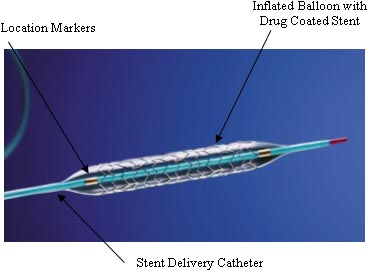


FDA
Home Page | CDRH Home Page | Search
| CDRH
A-Z Index | Contact CDRH
![]()
   |
| FDA
Home Page | CDRH Home Page | Search
| CDRH
A-Z Index | Contact CDRH
|
 |
 |
||||

This is a brief overview of information related to FDA's approval to market this product. See the links below to the Summary of Safety and Effectiveness and product labeling for more complete information on this product, its indications for use, and the basis for FDA's approval.
Product Name: TAXUS™ Express2™ Paclitaxel-Eluting
Coronary Stent System (Monorail and Over-the Wire Delivery Systems)
Applicant: Boston Scientific Corporation
Address: One Boston Scientific Place, Natick, MA 01760-1537
Approval Date: March 4, 2004
Approval Letter: http://www.fda.gov/cdrh/pdf3/p030025a.pdf
What is it and when is it used? The TAXUS™ Express2™ Paclitaxel-Eluting Coronary Stent is an expandable, slotted, stainless steel tube, with a drug (paclitaxel) contained within a thin polymer coating on its surfaces. The Stent is mounted over a deflated balloon attached to the end of a long thin flexible tube (stent delivery catheter).
The Stent is used in patients who have a narrowing in their coronary arteries (blood vessels supplying blood to the heart) caused by atherosclerosis -- the collection of fatty substances such as cholesterol that forms “plaque” along the lining of the arteries.
How does it work? A catheter with a deflated balloon at its tip is inserted into a blood vessel in the arm or groin, and advanced within the vessel, to the narrowed section of the coronary artery. The balloon is inflated within the narrowed artery to open the artery by pushing the plaque against the artery wall (balloon angioplasty).
The angioplasty balloon and its catheter are withdrawn from the patient; then the stent, mounted on another deflated balloon catheter (stent delivery catheter), is advanced through the same vessel and positioned within the expanded coronary artery. The balloon on the stent delivery catheter is inflated, causing the stent to expand to the size and contours of the vessel. This restores the opening in the artery allowing normal blood flow to the heart. The balloon on the stent delivery catheter is then deflated and the delivery catheter without the stent is removed from the patient. The stent remains permanently implanted within the coronary artery, acting as a support (scaffold) for the newly opened section of the vessel. The drug (paclitaxel) is slowly released into the artery wall around the stent.
What will it accomplish? Expansion of the stent within the narrowed section of a coronary artery opens the narrowing, allowing more blood flow to the heart. If the narrowing is not treated, it can lead to a heart attack (myocardial infarction) or even death. Sometimes, after a coronary artery stent procedure, re-narrowing of the artery occurs. This is due to overgrowth of normal tissue that occurs during the healing process. The drug, paclitaxel, is intended to limit this overgrowth of normal tissue.
When should it not be used? The TAXUS Express Stent should not be used in patients:
Additional information: Summary of Safety and Effectiveness and labeling are available at: http://www.fda.gov/cdrh/pdf3/p030025.html
Other:
National Institutes of Health, National Library of Medicine:
http://www.nlm.nih.gov/medlineplus/ency/article/002303.htm
Updated September 9, 2004
![]()
CDRH Home Page | CDRH A-Z Index | Contact CDRH | Accessibility | Disclaimer
FDA Home Page | Search FDA Site | FDA A-Z Index | Contact FDA | HHS Home Page
Center for Devices and Radiological Health / CDRH